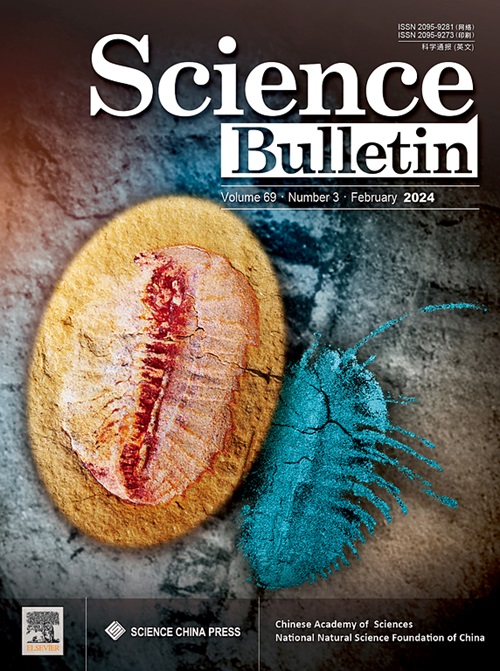利用含有铀酰特异性识别位点的荧光传感器进行高灵敏度和特异性铀酰离子检测。
IF 21.1
1区 综合性期刊
Q1 MULTIDISCIPLINARY SCIENCES
引用次数: 0
摘要
铀污染已严重威胁到人类健康和环境安全,因此环境铀污染的检测显得尤为重要。环境中铀的主要形式是铀酰离子,对铀酰离子的灵敏和特异性检测取决于化学基团对铀酰离子的特异性识别。本研究通过 1-乙基-3-(3-二甲基氨基丙基)碳二亚胺(EDC)和 1,1,2,2-四(4-羧基苯基)乙烯(TPE-(COOH)4)的反应,合成了一种含有高度特异性铀酰离子识别基团的新型荧光传感器。由于聚集诱导发射(AIE)和分子内电荷转移(ICT)的影响,这种名为 TPE-EDC 的荧光传感器在水环境中表现出显著的荧光特性。铀酰离子与 TPE-EDC 中的特定识别基团结合会降低 ICT 效应,从而导致 TPE-EDC 的发射强度显著降低。TPE-EDC 荧光强度的衰减与铀酰离子浓度的增加呈良好的线性关系。TPE-EDC 对铀酰离子具有超灵敏、超选择性的检测能力,检测限低至 69 pmol/L,响应时间超短至 30 秒。本文章由计算机程序翻译,如有差异,请以英文原文为准。

Highly sensitive and specific uranyl ion detection by a fluorescent sensor containing uranyl-specific recognition sites
Uranium pollution has become a serious threat to human health and environmental safety, making the detection of environmental uranium contamination of great importance. The sensitive and specific detection of uranyl ions, which are the dominant form of uranium in the environment, depends on the specific recognition of uranyl ions by chemical groups. In this study, a novel fluorescent sensor containing a highly specific uranyl ion recognition group is synthesized via the reaction of 1-ethyl-3-(3-dimethylaminopropyl) carbodiimide (EDC) and 1,1,2,2-tetra(4-carboxylphenyl)ethylene (TPE-(COOH)4). Owing to the effects of aggregation-induced emission (AIE) and intramolecular charge transfer (ICT), the fluorescent sensor, named TPE-EDC, exhibits significant fluorescent properties in aqueous environments. The binding of uranyl ions by specific recognition groups in TPE-EDC leads to a decrease in the ICT effect, thus causing a significant reduction in the emission intensity of TPE-EDC. The attenuation of the fluorescence intensity of TPE-EDC shows an excellent linear relationship with an increase in uranyl ion concentration. TPE-EDC exhibits ultra-sensitive and ultra-selective detection ability for uranyl ions with an ultra-low detection limit of 69 pmol/L and an ultrashort response time of 30 s. These high detection performances render the fluorescent sensor TPE-EDC a promising candidate for early warning of uranium pollution.
求助全文
通过发布文献求助,成功后即可免费获取论文全文。
去求助
来源期刊

Science Bulletin
MULTIDISCIPLINARY SCIENCES-
CiteScore
24.60
自引率
2.10%
发文量
8092
期刊介绍:
Science Bulletin (Sci. Bull., formerly known as Chinese Science Bulletin) is a multidisciplinary academic journal supervised by the Chinese Academy of Sciences (CAS) and co-sponsored by the CAS and the National Natural Science Foundation of China (NSFC). Sci. Bull. is a semi-monthly international journal publishing high-caliber peer-reviewed research on a broad range of natural sciences and high-tech fields on the basis of its originality, scientific significance and whether it is of general interest. In addition, we are committed to serving the scientific community with immediate, authoritative news and valuable insights into upcoming trends around the globe.
 求助内容:
求助内容: 应助结果提醒方式:
应助结果提醒方式:


